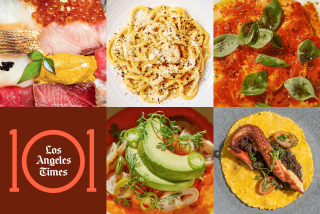Kitchen accomplished
SO this is where cookbook author Paula Wolfert has wound up: not somewhere in the Mediterranean but outside Sonoma. And not among the vineyards, either, but way, way out in the hills, where nothing edible grows, nothing but scrub and live oak.
To make it odder, Wolfert remains as indelibly Brooklynite in her attitudes as in her accent, so she still doesn’t drive, despite having lived in California for 11 years. One of the first things she asks a guest, with her trademark disarming grin, is, “Would you mind just driving back up to the main road to check our mailbox?”
It’s a house built in the woodsy, faintly Hobbity style that emanated from Marin County and Big Sur in the ‘60s, complete with oak tree branches growing up through holes in the pool deck. “Feels like a treehouse, doesn’t it?” Wolfert marvels as she leads a tour.
At first glance, the dominant feature here seems to be the dramatic living room, with its two-story picture windows looking out on a little valley that’s part of the property. Needless to say, though, the real center of gravity in this house is the kitchen, up in the loft that overlooks the living room.
It’s a spacious kitchen, as you’d expect, lavishly stocked with cupboards and drawers (not that Wolfert isn’t in serious danger of outgrowing all available storage space in the house). In the middle stands a huge island tiled with tumbled marble. On one wall, shelves of Mediterranean clay cookware reach to the ceiling. Blue-tiled counters extend almost all the way around the room.
It’s also, let’s say, an uncliched sort of space. Between its slanting ceiling and a basically diamond-shaped floor plan, the kitchen is full of odd sharp angles, left over from the original design of the house. (That must be why the island in the middle of the room ended up being built with six sides.)
There’s a theatrical quality to this kitchen, underlined by the fact that it’s completely open on one side to the dining area and the living room below it. Think of a restaurant display kitchen with just a touch of “The Cabinet of Dr. Caligari.”
Since the late 1950s, Wolfert has had kitchens in Paris, Morocco, New York, San Francisco and Connecticut (where she spent four accident-plagued years in what she suspects was a haunted house). By now, she’s spent nine years here in Sonoma -- longer than she’s lived anywhere except for Paris.
Because she likes it. “This place was something I deserved,” she says, “after all the little, tiny kitchens I’ve slaved in over the years.” In addition to all the space, she likes the sense of unspoiled nature and the bohemian tenor of her neighbors.
She came to the house in a New Yorker’s sort of way: reading a New York Times story about a house in the area in which the homeowners used bookcases as decoration. “We’d moved out West for space in the first place,” she says. “All our books were shoving us out of our home.”
She and her husband, Bill Bayer, went to meet them and fell in love with the idea of a neighborhood where people would cover all their walls with bookcases. When they learned there was another house for sale nearby, in a New York/Northern California minute they sold off two properties they owned on the East Coast and moved up into these hills.
The main thing they did, after putting in lots of bookcases (a guest bedroom became a library), was create a new kitchen.
“When we got the house,” Wolfert says, “there was just a narrow galley kitchen and a breakfast room here. We tore it all out.”
San Francisco architect John Powers says: “She wanted volume, above all. We took a back wall out. And she wanted it very open, but with a sense of warmth. She is as authentic as her food, and the kitchen reflects her, sensuous and tactile.”
Wolfert, the author of titles such as “Couscous and Other Good Food From Morocco,” “The Cooking of the Eastern Mediterranean” and “Mediterranean Grains and Greens,” wanted to have an Old World cooking hearth, so the kitchen has a wood-burning fireplace at waist level, outlined with tiles that suggest red brick.
“I cook in the hearth all the time too,” Wolfert says. A pile of clay pots with soot-stained bottoms vouches for that.
Even her gas oven has earthy Mediterranean capabilities, thanks to one of those stoneware inserts that foodies were keen on a couple of years ago to make their home ovens cook more like brick ovens. “It really works,” she says.
One thing Wolfert does not have is the sort of high-powered restaurant range that every Westside foodie longs to have. As a cookbook writer, she points out, she has to make her recipes usable in the ordinary home kitchen. So she’s kept the Thermador range and convection oven the house came with.
Just then the phone rings. “It’s from Tunisia,” she apologizes, “so I have to take it.” A Tunisian chef is coming to visit, it seems.
Wolfert is the sort of cook who likes having big, big dinner parties, so she has two dishwashers and a super-sized stainless steel sink.
“When we were remodeling, the architect wanted to put in a double sink. I said, ‘Excuse me?’ A real cook wants a great big sink, not one of those double sinks.
“He still thought I should have two sinks, though, so he sneaked a little one into the corner over there. You know what I use it for? Soaking my Romertopf pots.”
The dominant feature of the kitchen’s working area is the island, with its rough, rustic surface of white and ochre marble. “When I was working on the first edition of ‘The Cooking of Southwest France,’ ” she says, “I was living in New York and my kitchen was as small as a lot of people’s bathrooms. And I was making a lot of complicated recipes. I was pulling strudel on a card table, I swear -- I had to stretch it in two batches.
“So when we went to work on this place, I wanted a work table so big I couldn’t reach the center. It’s as big as a queen-size bed,” she adds proudly, and leans over it to demonstrate, luxuriously stretching her hands toward a center she can’t reach.
Wolfert’s latest book is a substantial rewrite of “The Cooking of Southwest France,” but her next will be on clay cookware, which she started collecting in 1955. She now has about 100 pieces. A lot of them are on display, and not just on those shelves. There’s hardly anything on the tiled counters but clay pots, except for a couple of mortars.
“Here’s the very first one I bought,” she says, bringing out a pale yellow tripiere, the sort of pot used in Caen, France, for stewing tripe. “I’ve never used it. I just loved the look of it.” It does have a soothing, grounded sort of shape, something between a round throw pillow and a particularly squat pumpkin.
Wolfert is enthusiastic about the cooking qualities of clay, which is perfectly suited to slow cooking: “It’s like magic. You can’t overcook things.” She points to a dish of eggplant that’s been frying quietly in duck fat all afternoon. Atop one high cupboard is an inconspicuous Tunisian couscoussier that turns out to have a secret compartment that holds fish at an even temperature while the couscous steams.
She does have plenty of metal pans and pots, but they’re all in drawers. “I like to have things out that have a story,” Wolfert says. “Why bother to look at them otherwise?”
So here’s a black tagine from the Rif region of Morocco. “Black clay cooks differently,” she says. “I bake cakes in this one.” An unglazed Tangiers-style oval pot for fish (“Unglazed I love”). A gedra dyal-trid, a specialized utensil which supports a clay dome over a fire (more or less like a clay wok holder) for making a rustic cousin of warqa, which is itself the Moroccan cousin of filo dough. She’s enthusiastic about the sandstone pots braced with wire that are used for cooking Chinese hotpot dishes.
Downstairs there’s a huge cooking library, shelf after shelf of books on Mediterranean cuisines: six on Morocco, three on Turkey and so on. There are more cookbooks in the cupboards too -- along with a lot more clay pots. The second-stringers, presumably.
Is there any kind of clay pot she doesn’t like? She pauses. “A raw one that’s never been cooked in yet. Can’t stand the sight of them.”
Putting together a kitchen is a personal thing. For one person it’s gingham and china, for another it’s shelves full of clay pots. When pressed, Wolfert has only a few suggestions to offer.
One is to have plenty of space for things you can use for impromptu meals. “One thing I learned about southwest French cooking,” she says, “is that it’s actually a convenience cuisine -- it’s all from the pantry. Most of the work is already done.” She opens her large refrigerator, and voila, it’s full of prunes in Armagnac and homemade duck confit, pretty much a dinner party waiting to happen.
Another idea she likes is putting vertical slots in place of some cupboards. Hers are in the central island, under the drawers where she keeps her spices (in jars arranged in alphabetical order). “Slots are the best way to store awkward flat things, like racks, pot lids, dough boards, paella pans and so on,” she says.
And if you hate the look of raw clay pots the way she does, here’s a final tip: Make a paste of ashes and olive oil, smear it all over the clay pot and put the pot in the oven for a couple of hours. The ancient patina of the Mediterranean kitchen is yours, quick-style.
Charles Perry can be reached at home@latimes.com.
More to Read
Eat your way across L.A.
Get our weekly Tasting Notes newsletter for reviews, news and more.
You may occasionally receive promotional content from the Los Angeles Times.






